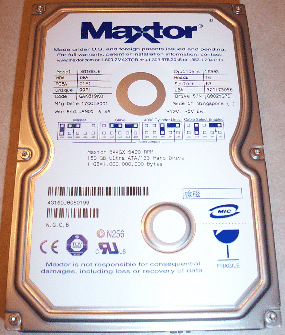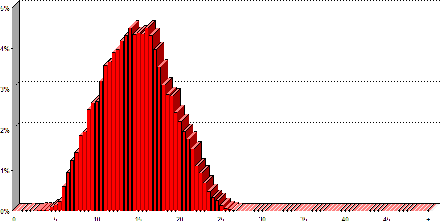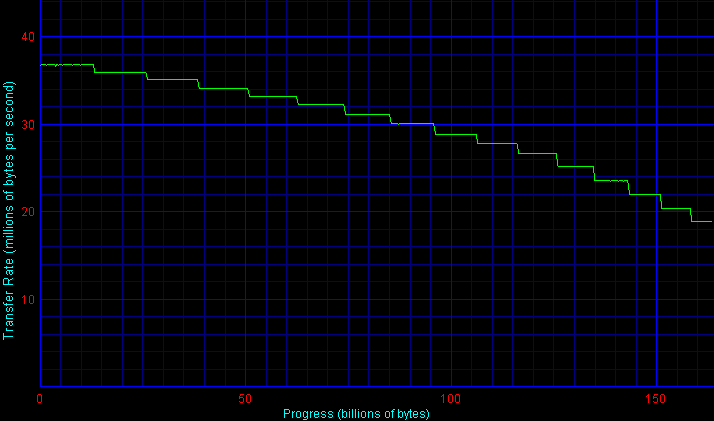|

Here we’ll take a look at the 160-gig flagship. This monster packs four of Maxtor’s latest 40 GB/platter disks into a single drive to explore previously unheard of capacities. Only Seagate’s aging Barracuda 180 offers slightly more space, albeit at the expense of the noise and heat associated with a half-height SCSI drive. An alarmingly high specified seek time accompanies the D540X- we haven’t seen the likes of 12 millisecond specs since Quantum’s 4400 RPM Fireball lct20. A two-megabyte buffer rounds out the offering. Maxtor protects the drive with a three-year warranty.
The 160 GB version of the D540X is the first to exceed the limitations of the venerable 28-bit LBA standard that limits ATA drives to 137 GB of capacity. Over the summer, Maxtor announced its “Big Drive” initiative; a move to extend addressable space to 48 bits… that’s 144 petabytes or 144 million gigabytes. Maxtor also stands alone among major drive manufacturers in pushing ATA-133, a last-gasp extension to a standard that looks to be phased out in favor of Serial ATA. Perhaps to make ATA-133 more attractive, Maxtor has bundled the “Big Drive” benefits of 48-bit addressing with ATA-133 in both marketing and in the physical controller bundled with the 160 GB units. To overcome the inherent capacity limitations present in most of today’s ATA controllers, a Maxtor-branded Promise Ultra133TX2 controller comes bundled in each box. Promise’s card not only offers ATA-133 operation but also includes the aforementioned 48-bit addressing.
Maxtor targets the ATA-133 versions (120 GB and 160 GB) of the D540X at those who need the most capacity they can get at the lowest possible price. These drives fit well in systems that need large amounts of space to backup or archive data. In these situations, its capacity and economy rather than absolute performance that’s key.

Low-Level ResultsFor diagnostic purposes only, StorageReview measures the following low-level parameters: Average Read Access Time– An average of 25,000 random accesses of a single sector each conducted through IPEAK SPT’s AnalyzeDisk suite. The high sample size permits a much more accurate reading than most typical benchmarks deliver and provides an excellent figure with which one may contrast the claimed access time (claimed seek time + the drive spindle speed’s average rotational latency) provided by manufacturers. WB99 Disk/Read Transfer Rate – Begin– The sequential transfer rate attained by the outermost zones in the hard disk. The figure typically represents the highest sustained transfer rate a drive delivers. WB99 Disk/Read Transfer Rate – End– The sequential transfer rate attained by the innermost zones in the hard disk. The figure typically represents the lowest sustained transfer rate a drive delivers. |
For more information, please click here.
|
Note: Scores on top are better. |
|
||||||||||||||||
|
||||||||||||||||
4G160J8 Average Read Service Time |
||||||||||||||||
Despite its specified seek time of 12 milliseconds, the D540X manages a respectable 14.8 millisecond average service (access) time. Subtracting 5.6 milliseconds to account for rotational latency yields a measured seek time of 9.2 milliseconds- well below Maxtor’s conservative estimate!
To negate the obscuring effect that write-back caching has on average random write access times, we traditionally disable write caching through the native Windows XP driver that powers our testbed motherboard’s ATA-100 controllers. Unfortunately, Promise’s drivers don’t feature a toggle to turn write caching off. Further, running the drive off of the motherboard controller would defeat attempts to gather a random access figure across the entire 160 gigabyte breadth of the drive. As a result, we regrettably cannot report average write service times.
|
Note: Scores on top are better. |
|
|||||||||||||||||||||||||||||||||
|
|
||||||||||||||||||||||||||||||||
4G160J8 Transfer Rate
|
|||||||||||||||||||||||||||||||||
Outer-zone transfer rates weigh in at 36.6 MB/sec, the highest we’ve recorded to date for a 5400 RPM unit. At 20.2 MB/sec, inner-zone rates are respectable though not outstanding.
Single-User PerformanceStorageReview uses the following tests to assess non-server use: StorageReview.com Office DriveMark 2002– A capture of 30 minutes of actual computer productivity use that exactingly recreates a typical office-style multitasking environment. The applications include: Outlook XP, Word XP, Excel XP, PowerPoint XP, Calypso (a freeware e-mail client), SecureCRT v3.3 (a telnet/SSH client), CuteFTP Pro v1.0 (an FTP/SSH client), ICQ 2000b), Palm Hotsync 4.0, Gravity 2.3 (a Usenet/newsgroups client), PaintShop Pro v7.0, Media Player v8 for the occasional MP3, and Internet Explorer 6.0. StorageReview.com High-End DriveMark 2002– A capture of VeriTest’s Content Creation Winstone 2001 suite. Applications include Adobe Photoshop v5.5, Adobe Premiere v5.1, Macromedia Director v8.0, Macromedia Dreamweaver v3.0, Netscape Navigator v4.73, and Sonic Foundry Sound Forge v4.5. Unlike typical productivity applications, high-end audio- and video- editing programs are run in a more serial and less multitasked manner. The High-End DriveMark includes significantly more sequential transfers and write (as opposed to read) operations. |
StorageReview.com Bootup DriveMark 2002– A capture of the rather unusual Windows XP bootup process. Windows XP’s boot procedure involves significantly different access patterns and queue depths than those found in other disk accesses. This test recreates Windows XP’s bootup from the initial bootstrap load all the way to initialization and loading of the following memory-resident utilities: Dimension4 (a time synchronizer), Norton Antivirus 2002 AutoProtect, Palm Hotsync v4.0, and ICQ 2000b.
StorageReview.com Gaming DriveMark 2002– A weighted average of the disk accesses featured in five popular PC games: Lionhead’s Black & White v1.1, Valve’s Half-Life: Counterstrike v1.3, Blizzard’s Diablo 2: Lord of Destruction v1.09b, Maxis’s The Sims: House Party v1.0, and Epic’s Unreal Tournament v4.36. Games, of course, are not multitasked- all five titles were run in a serial fashion featuring approximately half an hour of play time per game.
For more information, please click here.
|
Note: Scores on top are better. |
The DiamondMax D540X scores a 270 in the StorageReview.com Office DriveMark 2002, significantly outpacing other 5400 RPM drives from Seagate as well as a previous Maxtor unit. It nonetheless trails all 7200 RPM drives that have made their rounds in Testbed3. Not surprising, considering the D540X’s orientation as “mass storage for cheap.”
This situation pretty much plays itself out in all our other Desktop DriveMarks: the D540X’s huge capacity allows it to simply overpower other 5400 RPM units but isn’t enough to place it within the scores of the 7200 RPM realm.
Multi-User PerformanceStorageReview uses the following tests to assess server performance: StorageReview.com File Server DriveMark 2002– A mix of synthetically-created reads and writes through IOMeter that attempts to model the heavily random access that a dedicated file server experiences. Individual tests are run under loads with 1 I/O, 4 I/Os, 16 I/Os, and 64 I/Os outstanding. The Server DriveMark is a convenient at-a-glance figure derived from the weighted average of results obtained from the four different loads. StorageReview.com Web Server DriveMark 2002– A mix of synthetically-created reads through IOMeter that attempts to model the heavily random access that a dedicated web server experiences. Individual tests are run under loads with 1 I/O, 4 I/Os, 16 I/Os, and 64 I/Os outstanding. The Server DriveMark is a convenient at-a-glance figure derived from the weighted average of results obtained from the four different loads. For more information click here. |
|
Note: Scores on top are better. |
|
|||||||||||||||||||||||||||||||||
|
|
||||||||||||||||||||||||||||||||
5400 RPM drives simply aren’t meant to be placed in server’s that handle anything but the lightest traffic. Unsurprisingly, though it manages to best other 5400 RPM drives, the D540X simply can’t compete with 7200 RPM drives let alone the 10k and 15k drives that roar ahead in these suites.
Legacy PerformanceeTesting Lab’s WinBench 99 Disk WinMark tests are benchmarks that attempt to measure desktop performance through a rather dated recording of high-level applications. Despite their age, the Disk WinMarks are somewhat of an industry standard. The following results serve only as a reference; SR does not factor them into final judgments and recommends that readers do the same. |
|
Note: Scores on top are better. |
|
|||||||||||||||||||||||||||||||||
|
|
||||||||||||||||||||||||||||||||
The Promise Ultra133TX2 drivers are apparently highly optimized for WinBench 99 as evidenced by the D540X’s high WinMark scores. Note that the higher-level, more “real world” SR Desktop DriveMarks do not back up these scores.
Heat and NoiseIdle Noise– The sound pressure emitted from a drive measured at a distance of 18 millimeters. The close-field measurement allows for increased resolution between drive sound pressures and eliminates interactions from outside environmental noise. Note that while the measurement is an A-weighted decibel score that weighs frequencies in proportion to human ear sensitivity, a low score does not necessarily predict whether or not a drive will exhibit a high-pitch whine that some may find intrusive. Conversely, a high score does not necessarily indicate that the drive exhibits an intrusive noise envelope. Net Drive Temperature– The highest temperature recorded from a 16-point sample of a drive’s top plate after it has been under heavy load for 80 minutes. The figures provided are net temperatures representing the difference between the measured drive temperature and ambient temperature. For more information, please click here. |
|
Note: Scores on top are better. |
|
|||||||||||||||||||||||||||||||||
|
|
||||||||||||||||||||||||||||||||
A four-platter 5400 RPM drive is a rare beast indeed these days. Despite its platter count, however, subjectively speaking the D540X doesn’t produce any discernable idle noise in our testbed. Seeks are muted and barely audible. Objectively speaking, the drive’s score of 45.5 dB/A is a bit louder than other 5400 RPM units- both the Seagate U6 and Maxtor’s own 536DX measure in at whisper-quiet levels.
The D540X runs coolly, generating little heat despite the four platters. At 16.3 degrees above ambient, its one of the coolest drives we’ve measured using SR’s Renaissance testing suite.
ConclusionThe flagship 160 GB DiamondMax D540X finds itself in an interesting situation. What’s clear is that it undoubtedly offers more capacity than any other low-profile drive around. The extra space and requisite ATA controller, however, come at a cost that places the 160 GB D540X squarely against Western Digital’s Caviar WD1200BB, an ATA drive that leads the pack in terms of a performance-capacity balance. For many folks, it may be worth sacrificing the extra 40 gigs and the hassle of an additional PCI controller in favor of the significant performance increase that the WD1200BB offers. The 120 GB D540X is a clearer choice. Without the burden of a required new controller, it easily offers the best capacity/cost ratio around and is the clear choice for those who require massive archival storage space. This isn’t meant to spurn the flagship drive nor the Ultra133 controller. We’re pleased to see Maxtor take the initiative in clearing the way to the inevitable higher capacities. |




 Amazon
Amazon